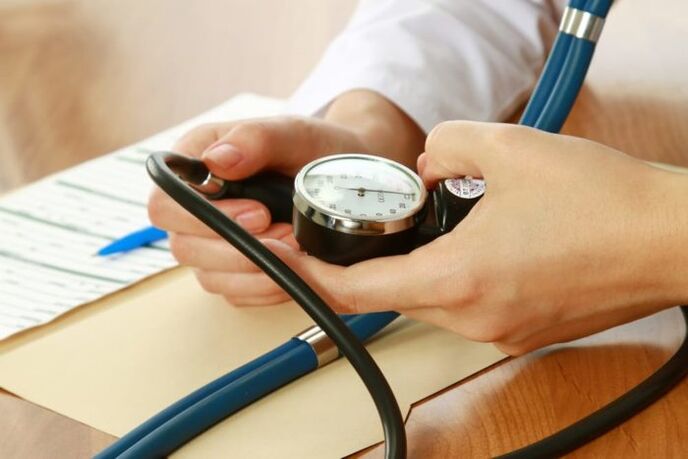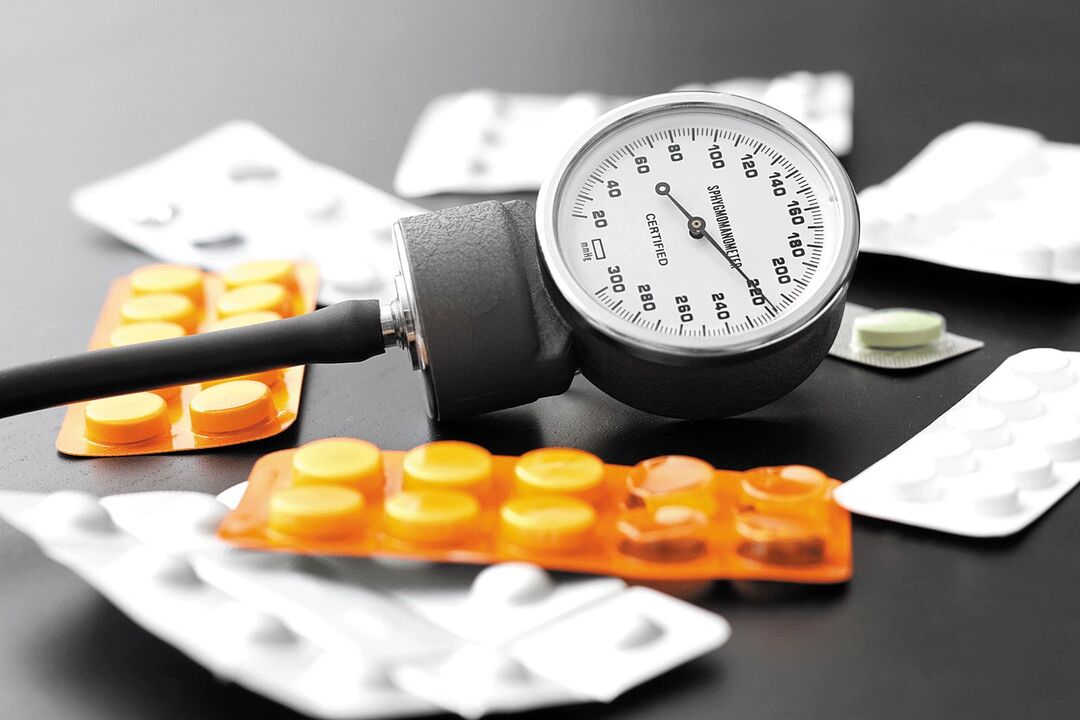The fact that there is a diagnosis of hypertension is thought of only when there is a persistent increase in blood pressure on the face, or frequent jumps occur. At the same time, different stages of hypertension are manifested by different strengths. In the early stages of the disease, people are usually unaware of the development of the problem. Sometimes even a slight rise in temperature is given more attention than a violation of the condition when arterial hypertension develops. The types of pathology differ in the severity of the manifestation of symptoms and the presence of concomitant disorders in the body. In fact, even in the absence of obvious signs, high blood pressure is no less dangerous than when it is supplemented by various disorders in the body. Signs of hypertension include: trembling limbs, nausea, headaches, flies in front of the eyes. All symptoms are due to problems with blood flow to the internal organs.

Stages of hypertension
The clinic of hypertension, in accordance with the effect on the whole body and the intensity of the accompanying symptoms, is divided into stage and severity. There are 3 phases. The division into phases helps the doctor to systematize the obtained diagnostic data and choose the right tactics to correct the patient's condition.
1 phase
The level of blood pressure in the first phase of hypertension does not exceed 159/99. This increase may take several days. Rest will help normalize blood pressure, relieve stress. With the further progression of the pathology, it will not be so easy to restore the norm of pressure.
At this stage of the disease, there are no signs of affecting the target organs. For this reason, arterial hypertension is often asymptomatic. Only sometimes sleep is disturbed, implicit pains in the head and heart can develop.
During the clinical diagnosis, a slight increase in the tone of the fundus arteries can be established. In the first stage of the disease, the risk of hypertensive crisis is minimal, often this situation occurs only due to the influence of external circumstances on the body. The risk also increases in women during menopause. The initial stage responds well to treatment. A lifestyle change is usually enough for this. Medications are not always needed. With timely therapy and strict adherence to the doctor's instructions, the prognosis will be favorable.
2nd stage
This is the phase of active pathological changes in the blood vessels - severe hypertension. The pressure in phase 2 reaches 179/109. Rest does not return to its level. The person complains of severe headaches, shortness of breath during exertion, worsening of sleep, dizziness and rapid heartbeat.
This phase is characterized by the development of the first signs from the internal organs. The most common symptoms of severe hypertension are:
- signs of left ventricular hypertrophy;
- narrowing of the retinal artery lumen;
- increase in blood cholesterol;
- the presence of protein in the urine.
Stage 2 hypertension significantly increases the risk of dangerous complications that can lead to stroke. Without constant medical treatment, it will not work.
3rd stage
This is a phase of disorders in the target organs due to pathological changes in the arteries and impaired blood flow throughout the body. Very severe hypertension in stage 3. The last stage of hypertension is the most severe, extensive disorders that develop in the body that affect the target organs. The eyes, kidneys, brain and heart are the most affected. Stage 3 pressure is stable, difficult to normalize even with drug treatment. There are often jumps up to 180/110 mm Hg. Art. and even more. The symptomatology is similar to the one that occurs in the 2nd phase, but it is also accompanied by pathological manifestations from the affected organs. Memory often deteriorates, heart rate is severely impaired, visual acuity decreases.
This phase is dangerous because it always hits the heart. Its contractility and conduction of impulses in the myocardium are disturbed.
Degrees
With the increase in blood pressure and the lack of effect of the measures taken, it can be assumed that the disease is progressing. The optimal level of blood pressure is 120/80. The norm of systolic pressure ranges from 120 to 129, and diastolic from 80 to 84. There is also a high normal pressure when a person feels well - up to 139/89 mm Hg. Art. In medicine, hypertension is divided into 3 degrees.
I degree
Grade 1 arterial hypertension is mild, characterized by pressure drops and fluctuations from 140/90 to 159/99. The risk of crisis in such a situation is minimized, there are no symptoms of dysfunction of other organs and the central nervous system. To suppress the attack, in addition to taking special pills, it is necessary to relax a little, try to avoid stress, walks and positive emotions have a beneficial effect on health.

If systolic pressure does not exceed 159, and diastolic - 99 mm Hg. Art. , then the person is diagnosed with mild hypertension - first degree. It is characterized by the following signs:
- headaches that worsen on exertion;
- sting, pain on the left side of the chest, radiating to the shoulder blade and under the arm;
- dizziness that is so intense that it can lead to fainting;
- accelerated heart rate;
- black flies;
- tinnitus;
- sleep disorders.
A person stops noticing these symptoms if they are constantly developing. An attack of hypertension can begin under the influence of stress and with proper help pass without sequelae.
II degree
Grade 2 hypertension begins to develop more actively. The pressure level is already reaching 160/100 - 179/109. Signs of a hypertensive crisis are developing - cold sweat appears, the skin is itchy, the skin on the face becomes red.
Symptoms of grade 2 disease are:
- transient cerebral ischemia - worsening of blood flow in the organ;
- increase in the concentration of creatinine in the blood;
- narrowing of arteries in the retina;
- increase in left ventricular size;
- protein in the urine, which is found during test delivery;
- persistent fatigue;
- nausea;
- pulsations in the head;
- facial swelling;
- heavy sweating;
- damage to internal organs;
- numbness of the fingers;
- blurred vision;
- crisis.
Medications do not cope well with the normalization of the patient's condition. Doctors pay attention not only to the level of pressure, but also to the speed of disease development. Grade II hypertension affects the kidneys. The patient almost always complains of malaise.
III degree
The third degree of hypertension is the most severe. When it occurs, vision drops sharply, memory deteriorates, tachycardia often occurs and there is a high risk of hypertensive crisis. Complications of this condition include thrombosis, encephalopathy, aneurysm, kidney and left ventricular failure, bruising all over the body, and swelling of the optic nerve. The pathology is irreversible. With grade 3 hypertension, the patient urgently needs outside help. The main signs of hypertension are:
- arrhythmia;
- gait instability;
- significant visual impairment;
- violation of blood flow to the brain, causing paresis and paralysis;
- crisis, followed by confusion and speech impairment;
- sharp pain in the heart;
- coughing up blood;
- restricted mobility and self-service ability;
- inability to communicate properly.
These symptoms indicate the progression of hypertension and the involvement of new organs in the disease. Gradually, more irreversible complications develop.
Classification according to risk factors
Hypertension is, above all, dangerous due to its multiple and often irreversible complications. Most patients become incapacitated or die not especially due to high blood pressure, but from acute disorders in other organs that it causes.
The most dangerous conditions are ischemic necrosis, cerebral hemorrhage, heart attack, kidney failure. In order to prevent various complications related to the dysfunction of other organs, the doctor determines the degree of risk during the examination. Risk levels are indicated by numbers from 1 to 4. It turns out that the diagnosis contains information about the degree and risk of damage, for example, GB 2 degree, risk 4.
Low risk (negligible)
This risk indicator for the development of complications of hypertension has been observed in women younger than 65 and men younger than 55 with mild stage 1 hypertension. In the next 10 years, only 15% of people develop additional cardiac and vascular disorders due to hypertension. These patients are most often examined by general practitioners, because it makes no sense to visit a cardiologist and carry out serious treatment.
When minor risks persist, a person must change their lifestyle over the next 6 months. This will lead to positive developments. If there are no results and a reduction in blood pressure cannot be achieved, it is recommended to change the tactics of patient management and conduct drug therapy.
Medium risk
This group of patients includes hypertensive patients, whose blood pressure indicators do not exceed 179/110. As a rule, these people have 1-2 risk factors from the following:
- smoking;
- genetics;
- obesity;
- high cholesterol;
- lack of physical activity;
- impaired glucose tolerance.
In the next 10 years, dangerous cardiovascular pathologies develop in 20% of cases. Organizing a proper lifestyle is an integral part of maintaining good health. Medicines should not be prescribed for 3-6 months so that the patient can regain health as much as possible through lifestyle changes.
high risk
This risk group includes patients with indicators 179/110 or more in the presence of more than 2 predisposing factors. There is also a high risk for people with target organ damage, diabetes mellitus, retinal vascular disorders and atherosclerosis.
There may also be no risk factors, but people with stage III hypertension are at high risk anyway. They must be treated by a cardiologist. The risk of complications is 30%. Lifestyle normalization is used only as an additional tactic against the background of taking specially selected medications. The choice of the most effective drugs should be made as soon as possible.
Approaches to treatment
The main goals of treating hypertension are to reduce pressure and prevent sequelae. Complete recovery is impossible, but the stage and adequate treatment help to stop the active progression of the pathology and minimize the risk of hypertensive crisis.
Drug therapy usually involves the use of antihypertensive drugs that inhibit the production of norepinephrine and its vasomotor activity. At the same time it is necessary to appoint diuretics, antiplatelet agents, hypoglycemic, hypolipidemic and sedative drugs. In the absence of the expected result, the combined effect of several antihypertensive drugs is carried out simultaneously.
In a hypertensive crisis, it is necessary to reduce the pressure within an hour after the attack, because otherwise the risks of dangerous complications and death increase. In such a situation, antihypertensive drugs are used by injection or drip.

Regardless of the degree and degree of dysfunction of the body, an important method of therapy is the normalization of diet, adherence to a special diet. The diet must include foods enriched with magnesium, potassium and vitamins. It is necessary to limit the use of salt, give up alcohol, fried and fatty foods. With obesity, the daily content of calories in the diet is reduced, sugar, pastries and other confectionery products are prohibited.
People with hypertension benefit from moderate physical activity - exercise therapy, swimming, walking. Therapeutic massage also has a good effect on the well-being of hypertension. Smoking is strictly forbidden, it is necessary to develop resistance to stress with the help of psychotherapeutic practices and relaxation techniques.
The effectiveness of complex therapy is evaluated according to several criteria:
- The short-term goals are to normalize the pressure to a level where the patient feels well.
- The medium-term goals are to prevent the occurrence and active development of pathologies in the target organs.
- The long-term goals are to prevent complications and prolong the patient's life.
Hypertension is a disease that is much easier to prevent than to fight a lifetime, trying to alleviate the symptoms and prevent a systematic worsening of the condition. The earlier the diagnosis is made and the stage of hypertension is determined, the more effective the treatment will be.



























